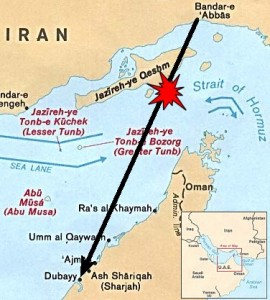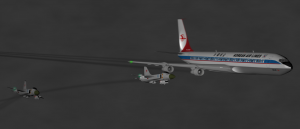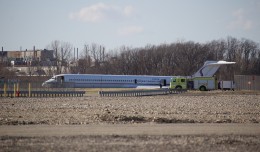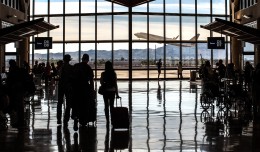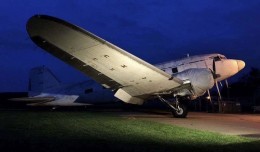The shoot down of Malaysia Airlines Flight 17 over the skies of Ukraine by a surface-to-air missile has once again brought tragic circumstances to light: commercial aircraft are not immune from such acts of war. However, this is not the first time that acts such as these have become front page news and provoked widespread condemnation.
Two of the most widely known incidents that have involved the downing of commercial airliners both occurred in the 1980s. The first was the shoot down of Korean Air Lines flight 007, a Boeing 747, west of Sakhalin Island in the Sea of Japan by a Soviet fighter jet in 1983. The second was the destruction of Iran Air flight 655, an Airbus A300, over the Persian Gulf by a surface-to-air missile fired by the United States Navy cruiser USS Vincennes in 1988.
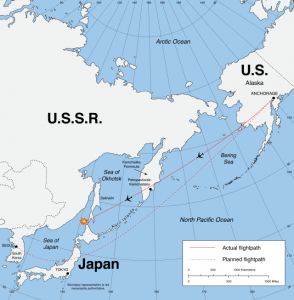 Korean Air Lines flight 007 was a Boeing 747-230B bearing the registration HL7442. It was on a flight from New York’s John F. Kennedy Airport to Seoul, South Korea via a fuel stop in Anchorage, Alaska on September 1, 1983. After departing Anchorage, the airliner set its course for Seoul. During the flight, the crew reported their estimated position as required. However these estimates were inaccurate, and the flight eventually found itself 160 nautical miles off course as it approached the Kamchatka Peninsula. The aircraft entered Soviet airspace over the Kamchatka Peninsula and then re-entered international airspace over the Sea of Okhotsk.
Korean Air Lines flight 007 was a Boeing 747-230B bearing the registration HL7442. It was on a flight from New York’s John F. Kennedy Airport to Seoul, South Korea via a fuel stop in Anchorage, Alaska on September 1, 1983. After departing Anchorage, the airliner set its course for Seoul. During the flight, the crew reported their estimated position as required. However these estimates were inaccurate, and the flight eventually found itself 160 nautical miles off course as it approached the Kamchatka Peninsula. The aircraft entered Soviet airspace over the Kamchatka Peninsula and then re-entered international airspace over the Sea of Okhotsk.
Soviet military command, which was tracking the aircraft, found it suspicious that the flight was heading for Sakhalin Island and ordered two fighters to intercept the airliner. According to transcripts that were released after the dissolution of the Soviet Union, military commanders initially thought that because the aircraft had 4 engines, it was a United States Air Force RC-135 reconnaissance aircraft. The interceptor following the Korean flight was a Sukhoi Su-15 “Flagon”, flown by Major Gennadi Osipovich. The fighter aircraft fired an R-98 medium range air-to-air missile which exploded about 160 feet behind the tail of the 747, causing a rapid decompression of its pressurized cabin.
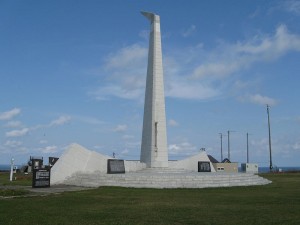
The “Tower of Prayer” is a monument in Japan to those who perished aboard Korean Air Lines Flight 007. Image courtesy Wikimedia Commons.
The crew of the Korean flight executed an emergency descent from its cruising altitude of 35,000 feet to altitude with breathable air of 16,400 feet. It remained at that lower altitude for 5 minutes before spiraling down over Moneron Island. Ultimately, the cost of life was all of the 246 passengers and 23 crew aboard the Korean aircraft. A great deal of the information about the search and rescue efforts did not come to light until after the break up of the Soviet Union. In 1992 Boris Yeltsin, the first president of the Russian Federation, released the cockpit voice recorder and flight data recorder as a goodwill gesture. Following the release of the two recorders, a great deal more became known about the fate of Korean Air Lines Flight 007. (Authors note: Although KAL007 was shot down by Soviet forces, this article in no way suggests that Russian forces were the cause of the destruction of MH17.)
Iran Air Flight 655 was a regularly scheduled flight between Tehran, Iran and Dubai, United Arab Emirates, with a stop in Bandar Abbas, Iran. On July 3, 1988, an A300B2-203 bearing registration EP-IBU, took off from Bandar Abbas International Airport. The flight it was operating should have been a 28 minute hop across the Persian Gulf to Dubai. On the same day, a helicopter from the USS Vincennes operating in the Persian Gulf had taken small arms fire from Iranian gunboats that were sailing in international waters. The USS Vincennes pursued the gunboats and entered Iranian territorial waters.
While pursuing the gunboats, the USS Vincennes mistakenly identified the airborne airliner as an Iranian F-14 Tomcat fighter jet. The U.S. Navy ship initiated radio contact on both military and civilian frequencies. However, the ship made no attempt to reach the aircraft on air traffic control frequencies. The aircraft never responded to the radio calls, because it had never heard them. At 10:24am, the USS Vincennes launched two SM-2MR surface-to-air missiles at the approaching aircraft, one of which struck the aircraft, causing the Airbus to break-up in mid-air and fall into the ocean. All 274 passengers and 16 crew members onboard the aircraft were killed in what remains the seventh most deadly aviation incident or accident. While the United States expressed its regret at the loss of innocent lives, it never accepted responsibility or liability for its actions or made a specific apology to the Iranian Government.
These are just two of the most famous cases where airliners were shot down. Over the years, there have been a number of other commercial aircraft that have fallen prey to missile attacks. The earliest incidents occurred during World War II, with the first airliner shot down by a missile – a Lockheed Constellation that was operated by El Al in 1955. In the 1970s, two Vickers Viscounts operated by Air Rhodesia were shot down during the civil war in that country. And of course there was Korean Airlines Flight 902, which was similarly shot down by Soviet forces in 1978, though all but two of those onboard managed to survive. Each of these incidents has been an atrocity in its own right. Prior to Malaysia Airlines Flight 17, the most recent shoot down of a commercial airliner was a Mogadishu TransAVIAexport Airlines Ilyushin IL-76 that crashed on the outskirts of Mogadishu, Somalia in 2007. And while witnesses claimed they saw the aircraft being shot down, the Somali government insisted it was only a crash.
Regardless of the times that we live in, there will always be hot spots of conflict somewhere in the world. Because of that, there will always be a threat against commercial airliners. For years now, there have been discussions of providing some form of protection in the air for these aircraft. Maybe the time has come to explore these options further to provide protection not only for the aircraft, but for the passengers traveling on those aircraft.



